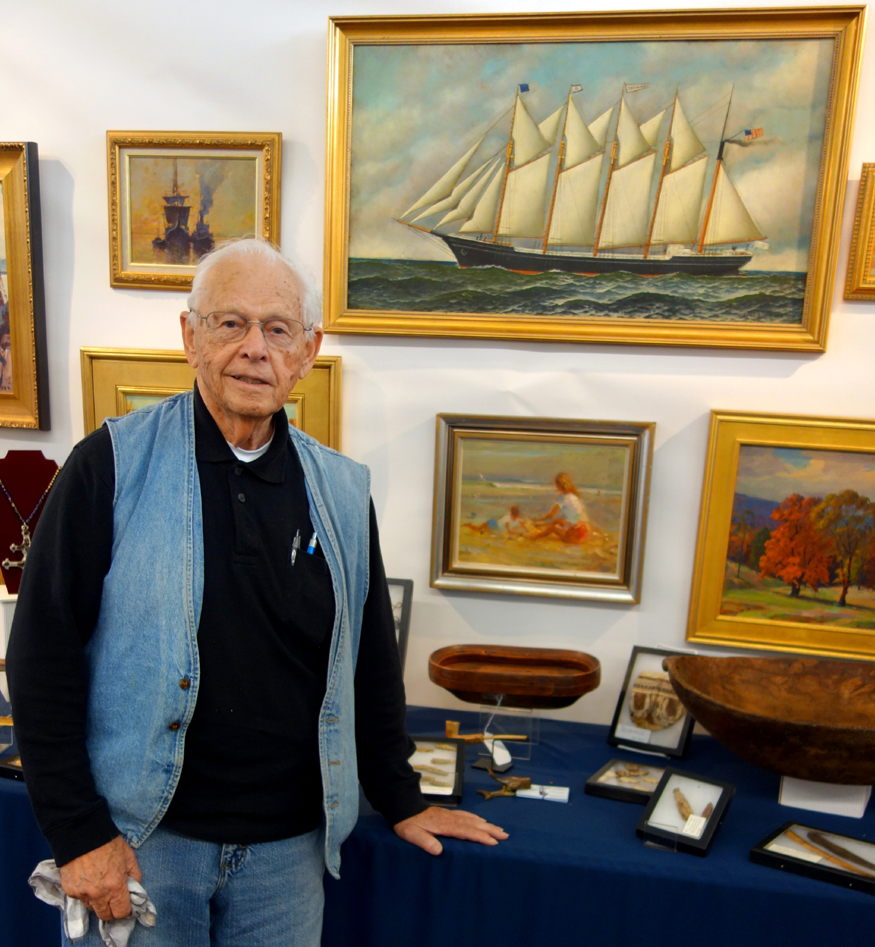
Justin Cobb of Captain’s Quarters Antiques, Amherst, Mass., says he is cutting back on shows in 2016.
After 35 years in the antiques business, Justin Cobb, 88, plans to slow down in 2016. Cobb, who operates Captain’s Quarters Antiques in Amherst, Mass., became a dealer after retiring in 1987 from the physical education department of the University of Massachusetts. Prior to that, he coached sports at the high school and college level. Cobb considered three choices for a second-career. He thought about learning to service heating and cooling systems; operating a charter boat for fishermen, building on his lifelong interest in fishing; or going into the antiques business. Specializing in nautical art and antiques allowed him to combine two of three interests. As a youth, Cobb spent two years at Henry Ford’s Wayside School for Boys, a high school for disadvantaged youth in Sudbury, Mass. The program combined academic instruction with vocational training. Ford often visited the Wayside School and took the boys on early morning nature walks. Cobb said students spent two weeks in school, followed by two weeks working. Cobb worked on the school’s farm, raising hogs. Cobb has six children and seven grandchildren. His wife, a book dealer who died four years ago, was active in the antiques business, as well.
What sort of things do you sell?
I started with marine paintings and sailor-made artifacts, along with scientific instruments. Those have been the mainstays of my business, although I sort of morphed into Eskimo stuff. There’s been a fair amount of old Native-made bone and baleen items coming out of the Arctic. Their early stone carvings, reflecting their spiritual beliefs, are, I think, wonderful. I like items that were used by the Eskimos, such as sealskin clothing and textiles made with trade cloth. I’m less interested in the later Eskimo carvings, which I find too commercial.
Artifacts related to famous explorers like Robert Edwin Peary Sr (1856–1920) are now being retrieved from some of his campsites and they’re quite saleable. He led several expeditions over a 20-year period, so there were several camps. Marine art has been working well for me and I find the margins are better with paintings than with some of the other items. I tend to concentrate on the artwork and enjoy doing the research needed to learn about the artist and the subject matter.

Cobb sells paintings like this Boston Harbor view by the Massachusetts artist Arthur Diehl (1870–1929).
Where are you finding most of your stuff?
Some comes from collectors and I go to as many auctions as I can, especially the smaller ones. Much of what I buy goes into my show inventory. I’m down to about ten shows a year now. If I’m able to buy a particularly good item, I might put it into a specialized marine-arts auction. After the Vietnam War, a lot of good marine things came onto the market because the US Navy decommissioned many ships and they were bought by “ship breakers” on Taiwan. Ships wheels, carvings, navigation instruments and other stuff like that became available in quantity. It was bought by wholesalers in this country and they were a good source for me. Restaurants decorating with nautical themes were good customers for that material.
Are nautical and marine items subject to cycles?
Very definitely. After Christie’s sold an Antonio Jacobsen painting for $45,000 in 2012, everyone was looking for Jacobsens and prices jumped. Marine paintings by Theodore Valenkamph (1868–1924), a Swedish American artist who was active in Massachusetts, were hot for a while. The same holds true for everything. Prices and interest always go up and down.
So you plan to cut back?
Well, I plan to take it a little easier. I will be 89 next year and only plan to do one-day shows, none of the longer ones. I’ll quit shows when I am 90, but will continue going to auctions, looking for things that I may know more about than others in the audience. I’ll put that stuff into specialized marine auctions, but only with places that use the Internet. I don’t do much with the Internet myself, but auction houses that do use it reach many more buyers and have strong overseas interest in some of the stuff I sell.
—Rick Russack

